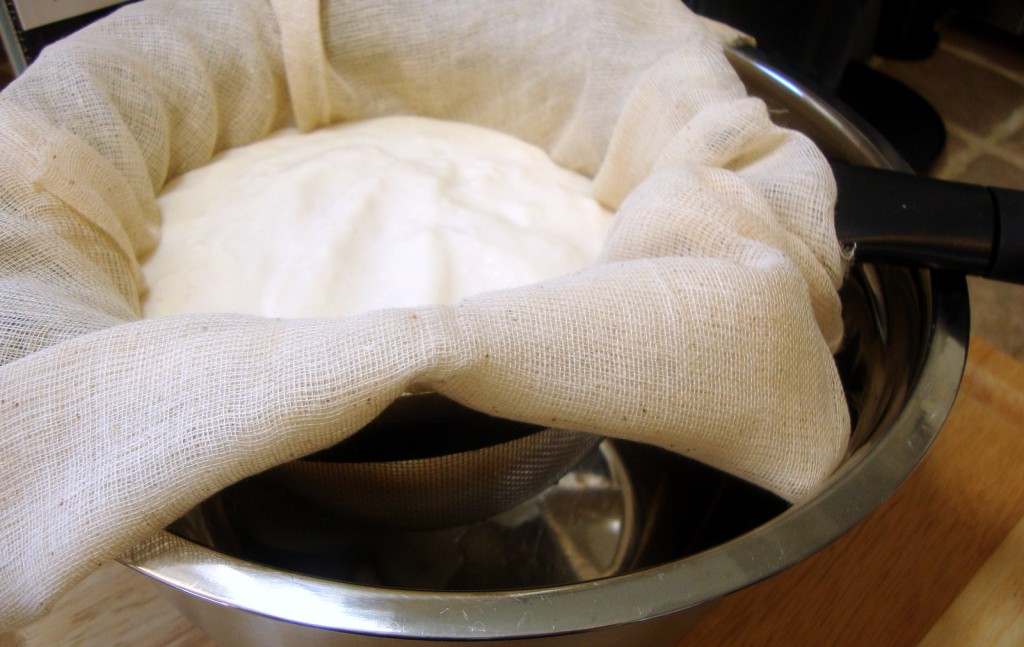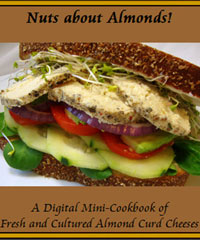This recipe produces a thick, creamy, tangy, plain Greek-style yogurt that requires no additional thickening agents such as food starches, gums, gels or pectin.
So why make your own yogurt? Because most commercial non-dairy yogurts have too much sugar and/or fruit added, too many thickening agents added and yet are still too runny to be useful for preparing yogurt-based cheeses or for condiments such as Greek Tzatziki and Indian Raita (which require a thick, unsweetened yogurt base). Of course, when not being used to make cheese or savory condiments, this yogurt can also be sweetened to your liking with organic sugar, natural syrups, fresh fruit or fruit preserves.
This yogurt is made with pure soymilk (soybeans and water with no additives). It may seem odd for a plain yogurt to include brown rice syrup in its preparation but there is a sound reason for this: Brown rice syrup is rich in dextrose, a natural sugar similar to glucose. It’s not used to sweeten the yogurt but rather to provide a food source for the yogurt culture (beneficial lacto-bacteria). Soymilk is too low in natural sugar to sufficiently provide this food source (some will argue that they make soy yogurt without adding a natural sugar food source but the results will not compare to yogurt prepared with this method).
As the soymilk cultures, the lactic bacteria consume the dextrose in the brown rice syrup and convert it to lactic acid. This gives the yogurt its familiar tanginess. Rest assured, you will not detect any sweetness in the finished yogurt. Brown rice syrup can be found in natural and health food stores and sometimes in the natural foods section of major supermarkets. If you cannot source it locally, it can be purchased through the internet.
You will need a commercial vegan yogurt starter to prepare your first batch (the yogurt can also be started using commercial plain soy yogurt with active cultures). Despite what the package directions may state, you will not need new sachets of starter to culture another batch of yogurt. As long as ¼ cup of yogurt is reserved from a previous batch, a new batch can be made successfully. I purchase my vegan yogurt starter from CulturesforHealth.com. It is very affordable and they ship quickly. Vegan yogurt starter is also available from BelleandBella.com. You may also be able to locate vegan yogurt starter elsewhere by doing a little internet searching.
For consistent results, I recommend using a commercial yogurt maker. Yogurt makers maintain the yogurt at a specific temperature for an extended period of time and are convenient and reasonably affordable. If your yogurt maker uses individual glass jars, set them aside. In this case, the yogurt needs to be cultured in a glass bowl that will fit inside the yogurt maker with the unit lid in place.
A commercial Greek-style yogurt strainer is a handy tool for straining yogurt but it is not required. The yogurt can easily be strained in a large sieve lined with fine muslin or a double layer of high-quality cheesecloth which has been placed over a large, deep bowl.
It is important to make sure all your containers and working tools are very clean before you begin so as not to contaminate the yogurt with undesirable bacteria or molds. This recipe yields about 3 cups or six ½-cup servings of plain Greek-style yogurt (be sure to reserve ¼ cup for starting your next batch!)
Ingredients
• 4 cups (1 qt) pure soymilk (soybeans and water with no additives)
• 2 T brown rice syrup
• ½ tsp fine sea salt or kosher salt
• 2 sachets (about ½ tsp each) vegan yogurt starter* – or ¼ cup soy milk yogurt (from a previous batch) – or ¼ cup commercial plain soy yogurt (with active cultures)
*Vegan yogurt culture starter is available by mail order from CulturesforHealth.com or BelleandBella.com.
Preparation
Pour the soymilk into a large saucepan and place over medium heat.
Add the salt and stir in the brown rice syrup. Cook the milk until steaming hot while stirring frequently. Simmering or boiling is unnecessary. Do not leave the saucepan unattended as the milk can boil over easily.
Remove the saucepan from the heat and allow cooling for 30 minutes. Stir occasionally while cooling to help the milk cool evenly and discourage a skin (yuba) from forming on the surface.
After 30 minutes of cooling, feel the bottom of the saucepan. If it is comfortably warm to the touch proceed to the next step; otherwise, let cool an additional 5 to 10 minutes and then test again. If desired, test the temperature of the mixture with an instant-read thermometer. It should not exceed 110°F/43°C (if the mixture is too hot, it will destroy the culture).
Whisk in the yogurt starter or yogurt until thoroughly blended. Pour the mixture into the yogurt maker. Put the unit lid in place and culture for 12 hours. No more; no less.
After culturing, refrigerate the yogurt in a covered container for a minimum of 8 hours or overnight. This will further develop the flavor and assist thickening.
Have a commercial Greek Yogurt strainer ready or line a large sieve with the muslin or double-layered cheesecloth and place over a large, deep bowl.
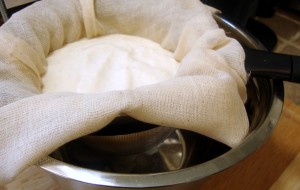
Pour the chilled yogurt into the strainer or sieve and allow draining for 2 hours at room temperature. Transfer it back to its storage container and refrigerate.
Consume or use the yogurt within 3 weeks (because yogurt is a cultured food, it may stay fresh longer, but 3 weeks is a rough guideline). Be sure to reserve ¼ cup for starting your next batch.
Chef’s note: Reserve the whey and chill in a sealed container if desired. I have discovered that the whey is a superb gluten-free alternative to rejuvelac for preparing the cultured cashew-based cheeses in my Non-Dairy Evolution Cookbook. The whey will stay fresh and active for about 5 days. Over time it will turn to vinegar and is no longer useable.
Print Recipe
Greek-Style Cultured Soy Yogurt
Votes: 51
Rating: 3.86
You:
Rate this recipe!
|
|
Votes: 51
Rating: 3.86
You:
Rate this recipe!
|
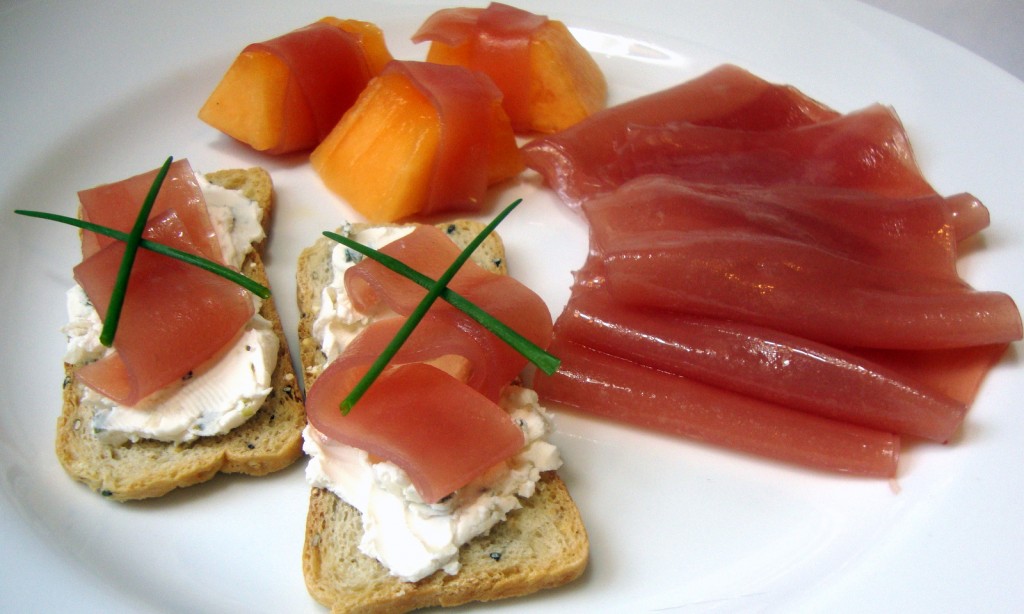 Prosciutto crudo is an Italian dry-cured ham that is usually thinly sliced and served uncooked. My vegan version is made from rice paper (a blend of tapioca starch and rice flour). While this may seem odd, the rice paper offers the translucency and sheen of thinly sliced pork-based prosciutto. For this recipe, use square rice paper sheets if you can find them. Round sheets will work too but the square sheets will yield more uniform slices. My original recipe yields three 3”x9” strips of mock prosciutto crudo.
Prosciutto crudo is an Italian dry-cured ham that is usually thinly sliced and served uncooked. My vegan version is made from rice paper (a blend of tapioca starch and rice flour). While this may seem odd, the rice paper offers the translucency and sheen of thinly sliced pork-based prosciutto. For this recipe, use square rice paper sheets if you can find them. Round sheets will work too but the square sheets will yield more uniform slices. My original recipe yields three 3”x9” strips of mock prosciutto crudo.
Ingredients
• 3 sheets rice paper (preferably square sheets)
• ¼ cup white shoyu (Japanese white soy sauce)
• ¼ cup water
• 2 tsp vegan Worcestershire sauce
• ¼ tsp beet powder
• olive oil
Preparation
Combine the white shoyu, water, Worcestershire sauce and beet powder in a cup and then pour into a large, shallow baking dish.
Stack the three sheets of rice paper together and then immerse in the marinade. Allow to soak until most of the marinade has been absorbed and the rice paper is moist and supple and nicely colored, about 10 minutes. The sheets will stick together – this is desirable. The three sheets of rice paper will yield one sheet of prosciutto.
Carefully transfer the mock prosciutto to a baker’s cooling rack to drain briefly. Transfer again to a work surface and slice into 3 strips. Rub the strips generously with olive oil to keep them moist and supple. The oil is essential and is not optional; without it the texture will be quite rubbery.
For the best texture experience, use the mock prosciutto immediately if possible. The strips can be stored in a food storage bag in the refrigerator if necessary but will acquire a chewier texture during storage. Use in your favorite recipe as desired. Mock prosciutto works well for baked appetizers too.
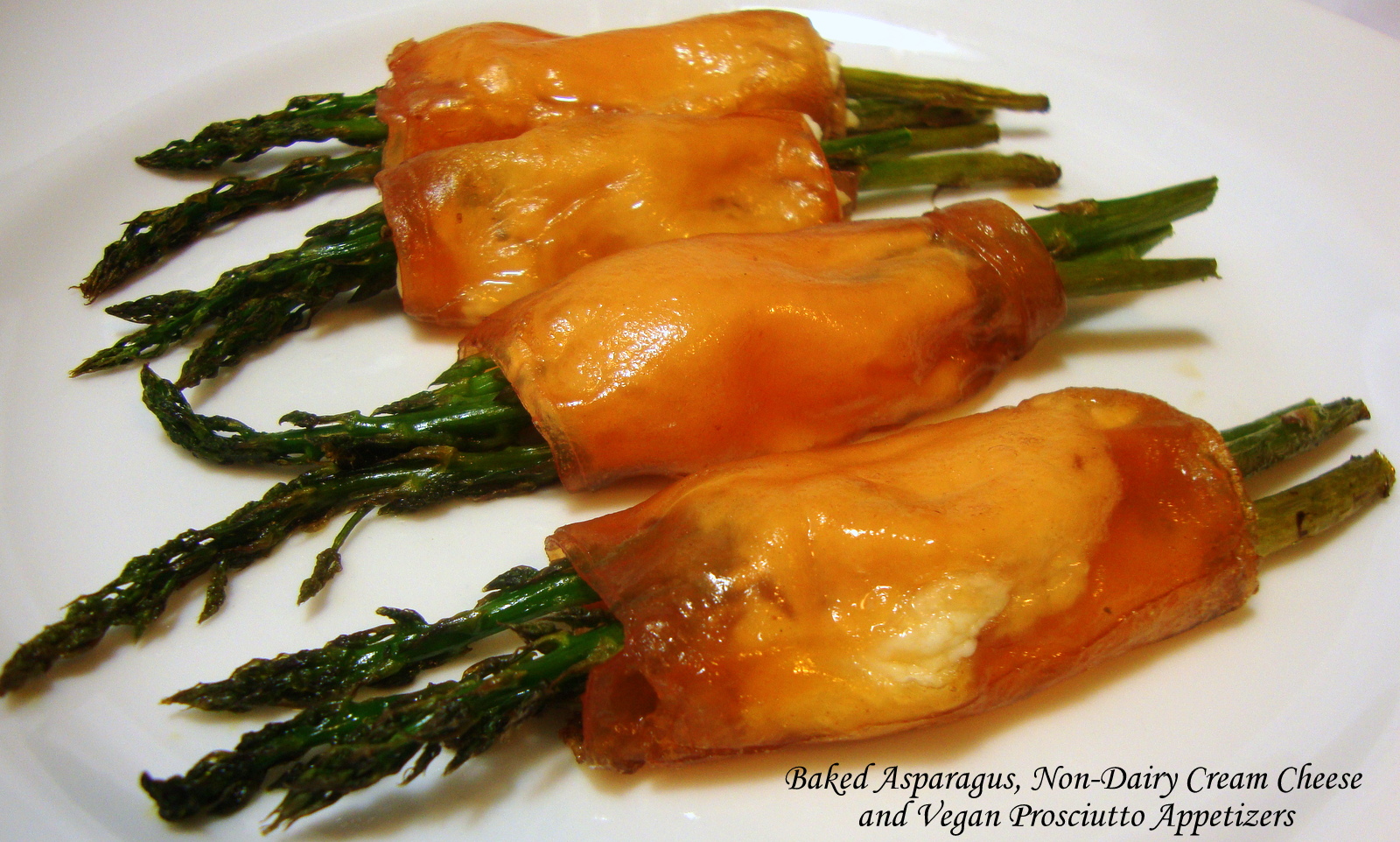
Print Recipe
Mock Prosciutto Crudo
Votes: 11115
Rating: 3.92
You:
Rate this recipe!
|
|
Votes: 11115
Rating: 3.92
You:
Rate this recipe!
|
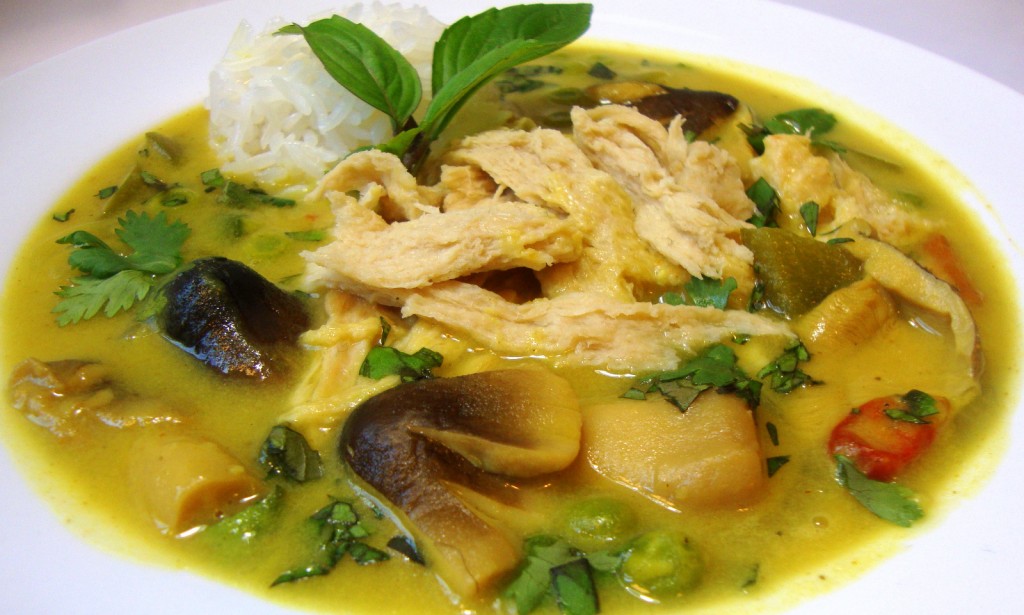 Ingredients
Ingredients
• 4 cups vegan no-chicken broth or similar
• 2 medium russet potatoes, peeled and diced
• 1 T grated ginger
• 3 cloves garlic, chopped
• 4 tsp yellow curry powder
• 1 medium onion, peeled and chopped
• 1 large green bell pepper, chopped
• 1 can (14 oz) coconut milk (full fat; not lite)
• ½ cup green peas, fresh or from frozen
• 1 can (15 oz) straw mushrooms
• 2 tsp sambal oelek (chili paste) or other hot red pepper sauce, or to taste
• a few Thai bird’s eye chilies (optional)
• 1 and ½ cup Stewing Chikun, torn into bite-size pieces; or Shredded Chikun (both from the Seitan and Beyond Cookbook; the Soy Chikun Strips from the same cookbook can be used as substitute if desired; or simply use bite-size cubes of pressed tofu or additional vegetables if you wish to omit the chikun or tofu entirely)
• sea salt or kosher salt, to taste
• chopped Thai basil for garnish (optional)
• chopped cilantro for garnish (optional)
• cooked jasmine rice for serving
Preparation
In a large soup pot, simmer the potatoes, ginger, garlic and curry powder until the potatoes are tender, about 20 minutes. Transfer to a blender and process until smooth (exercise caution when blending hot liquids; place a kitchen towel over the blender lid and begin on low speed progressing slowly to high speed).
Transfer the purée back to the soup pot. Place over medium-low heat and stir in the coconut milk.
Mist a skillet with cooking oil and sauté the onions and bell pepper over medium heat until softened. Add to the soup pot. Stir in the peas, mushrooms, sambal oelek and optional bird’s eye chilies. Cover and simmer about 20 minutes or until the bell pepper is very tender.
Add the Stewing Chikun and simmer an additional 10 minutes; season with salt to taste. If using Shredded Chikun, stir into the curry just before serving. Garnish with the Thai basil and cilantro.
Warning: Do not eat the bird’s eye chilies!
Print Recipe
Thai Yellow Chikun Curry
Votes: 0
Rating: 0
You:
Rate this recipe!
|
|
Votes: 0
Rating: 0
You:
Rate this recipe!
|
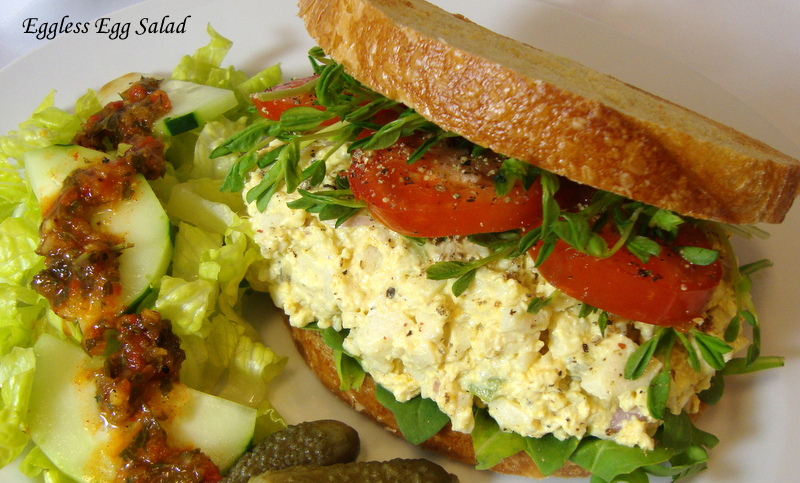 This tasty sandwich filling remarkably resembles real egg salad in appearance taste and texture, but without the cholesterol (or animal cruelty). A blender is required for preparing the “egg whites” and a food processor is recommended for the “yolk” mixture. You will also need 1 block (about 14 oz before pressing) extra-firm water-packed tofu (not silken tofu). Drain and press the tofu until it is not releasing any more liquid – this is very important! After pressing you should have approximately 12 ounces of tofu.
This tasty sandwich filling remarkably resembles real egg salad in appearance taste and texture, but without the cholesterol (or animal cruelty). A blender is required for preparing the “egg whites” and a food processor is recommended for the “yolk” mixture. You will also need 1 block (about 14 oz before pressing) extra-firm water-packed tofu (not silken tofu). Drain and press the tofu until it is not releasing any more liquid – this is very important! After pressing you should have approximately 12 ounces of tofu.
Ingredients for the “Egg Whites”
• ⅓ block (about 5 oz before pressing) extra-firm tofu (not silken tofu)
• ¾ tsp kala namak (Himalayan black salt)
• 2 cups water
• 2 and ¼ tsp agar powder
Ingredients for the “Yolk” Mixture
• ⅔ block (about 9 oz before pressing) extra-firm tofu (not silken tofu)
• ¼ cup eggless mayonnaise, plus additional as necessary for consistency
• 1 T nutritional yeast flakes
• 2 tsp prepared mustard, your choice of Dijon, spicy, golden or yellow
• ¼ tsp kala namak (Himalayan black salt), or more to taste
• ¼ tsp sweet paprika
• ¼ tsp ground turmeric
• 2 T minced shallot or red onion
• 1 rib of celery, diced
• coarse ground black pepper to taste
• optional ingredients sliced black olives, capers, or diced sweet or dill pickle
Preparation
Drain and press the tofu until it is not releasing any more liquid. Slice ⅓ of the tofu to use for the “egg whites. The remaining ⅔ will be used for the “yolk” filling.
To prepare the “egg whites”, place the “egg white” ingredients into a blender and process until smooth. Pour the mixture into a saucepan and bring to a simmer over medium heat, stirring frequently to avoid scorching the tofu mixture. Avoid boiling as this will cause the soy protein to re-coagulate (a minimal degree of re-coagulation may occur as the mixture is brought to a simmer but will not affect the final appearance or texture). Pour the mixture into the 8” baking pan and set aside to cool. After cooling a bit, refrigerate until completely set, about 1 hour.
Next, crumble the ⅔ pressed block of pressed tofu into a food processor and add the mayo, nutritional yeast flakes, prepared mustard, kala namak, turmeric and paprika. Process the contents until completely smooth, stopping as necessary to scrape down the sides of the food processor. Alternately, the mixture can be mashed using a fork but the mixture will not be as smooth.
Transfer the “yolk” mixture to a bowl or a food storage container and stir in the minced onion, celery, black pepper and any optional ingredients. Mix well, cover and refrigerate until ready to use.
Now, run a table knife around the perimeter of the “egg white” container to loosen if necessary and invert onto a work surface. Chop the “egg whites” into fine dice and transfer to a mixing bowl. Stir in the “yolk” mixture and add additional mayonnaise as necessary to thoroughly moisten the eggless salad. Season the mixture with additional salt and pepper as desired, cover with plastic wrap and chill thoroughly before serving.
Print Recipe
Eggless Egg Salad
Votes: 5
Rating: 5
You:
Rate this recipe!
|
|
Votes: 5
Rating: 5
You:
Rate this recipe!
|


